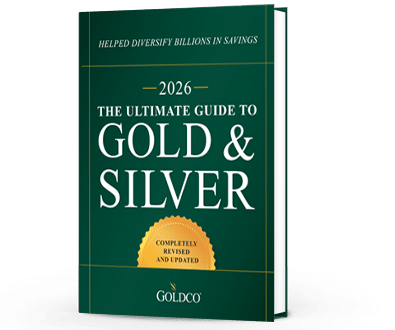3 Things That You Should Know About Inflation
Only a few short years ago, the United States experienced the highest inflation rates in over 40 years as inflation rates peaked at over 9% That was a wake up call for many Americans who had been...
Economy

The Federal Reserve’s Federal Open Market Committee (FOMC) held its most recent meeting this week and, while it didn’t deliver any surprises on the surface, digging deeper into the Committee’s statement makes you realize that higher inflation and easy money won’t be going away anytime soon. The outlook for the economy with a Fed intent on keeping the printing presses going at full speed isn’t a good one, as prices will likely only increase in the future.
With the Federal Reserve increasingly imposing itself on the economy, it has nearly become the arbiter of financial success, a position it was never envisioned it would assume. And increasingly the fates of investors and their assets are being caught up in the Fed’s actions.
The identity of the Federal Reserve Chairman may normally only be of concern to policy wonks, economists, and Washington insiders, but there are Fed Chairmen who have made their mark in popular culture. Ben Bernanke became a symbol of the response to the 2008 financial crisis. Alan Greenspan became synonymous with the stock market euphoria of the late 1990s under President Clinton. And Paul Volcker’s fight against inflation paired him with the goals of the Reagan administration.
Unfortunately, there have been other Fed Chairmen who haven’t been nearly as good. One of the worst in recent times was G. William Miller, appointed by President Carter in 1978. He didn’t even last 18 months in office before he was nominated to become Treasury Secretary. Miller’s weak stance towards fighting inflation was abhorred in Washington, and his tenure has become synonymous with failure.
The question before us now is whether Fed Chairman Jay Powell will go down in history as another Miller or as the next Volcker. Watching the Fed’s actions over the past year, there’s certainly nothing to give us any confidence that he’ll be anything like the latter.
In its latest FOMC statement, the Fed stated that it would continue purchasing at least $80 billion in Treasury securities and $40 billion in agency mortgage-backed securities per month. That’s nearly $1.5 trillion dollars of asset purchases per year, minimum. Notice that the statement doesn’t talk about an upper limit, so that the Fed remains free to purchase well more than those amounts, in the event the government continues to pass multi-trillion dollar spending bills to spend money it doesn’t have.
Powell, for his part, seems blissfully unaware of the problems facing the US economy. He recently stated that the financial system isn’t being threatened by “frothy” valuations, a statement that seems eerily reminiscent of Ben Bernanke’s statements in 2007 that problems in the subprime mortgage market were largely contained and wouldn’t spill over into the overall financial system. Whoops, he really got that one wrong.
You almost want to feel bad for Powell, that he just doesn’t get what we’re facing, which could be a repeat of 2008 just on a much larger scale. Like Miller, Powell isn’t an economist, he’s a lawyer. He cut his teeth on Wall Street, and has bounced around in government off and on over the past 20 years. But while he may not understand what’s happening, apparently no one else at the Fed does either.
There isn’t a single solid voice at the Fed sounding the warning, nor is there any dissent at FOMC meetings. No one wants to be the party pooper, and so all we hear from Fed officials is how they’re on top of things, how inflation isn’t really that bad, and how we have nothing to worry about. Ha!
It’s easy for them to say, with their cushy six-figure incomes and massive asset accumulation from their careers in finance and government. But like most people who have spent their careers in Washington or who have traveled through the revolving door between finance and government, their understanding of what ordinary people go through is sorely lacking.
When you make $150,000 to $400,000 a year for years or decades, you forget what it’s like to have to really budget and save. You don’t have to worry about whether you’re going to be able to get braces for your teenagers. You don’t have to worry about choosing between paying medical bills or putting food on the table. And you don’t have to worry about retirement because you have a nice retirement package already in place.
Perhaps more importantly, the Fed’s monetary policy benefits people in Washington and on Wall Street, further impacting their ability to empathize with the average American. Maybe Jay Powell does notice that the grocery bills are getting larger each month. But his investment assets are probably doing phenomenally thanks to the trillions of dollars the Fed has pumped into the financial system, so he thinks everything is working out in the end.
But what about people who don’t have hundreds of thousands or even millions of dollars of investments? Or more importantly, what about those who have scrimped and saved to build up a sizable nest egg and who risk losing everything in a stock market crash? Unlike Powell and his friends in Washington and on Wall Street, those ordinary Americans don’t have the resources to overcome a catastrophic loss to the value of their investments.
There’s an old joke that says that if the government says something, it’s likely that the opposite is true. But it’s more a truism than a joke today. So when you hear the Fed saying that inflation is still low, that rising prices aren’t being caused by inflation, or that asset prices aren’t excessively valued, it’s probably a safe bet that everything you’re hearing is dead wrong.
The experiment in monetary creation that we’re seeing today is on a scale that is mind-boggling. Both the size of the Fed’s balance sheet expansion and the speed with which it occurred have irrevocably changed the conduct of monetary policy going forward. It’s hard to imagine the Fed being able to wrangle the genie back into the bottle now that it has created trillions of dollars in a single year.
The danger to savers and investors will only continue to grow as the Fed continues its asset purchases. Most analysts don’t expect the Fed to end asset purchases this year, or even to taper them by next year. And with no upper limit to the amount of money the Fed can create to purchase new government debt, the government can spend itself into oblivion while the Fed stands by aiding and abetting it.
Perhaps at no other time in our country’s history has the possibility of out of control inflation been so great. We’re standing on the precipice of a potentially catastrophic economic collapse, with the Fed’s monetary mismanagement leading the charge. Millions of Americans could see the purchasing power of their savings wiped out, with nothing they can do about it.
That’s why it’s more important than ever to try to protect your savings while you still can. Once the next crisis is underway, it’s going to be too late to try to protect your assets while everyone else is doing the same thing. Proper preparedness now can save you plenty of pain in the future.
More and more investors today are turning to gold and silver to protect their assets against inflation, hedge against a stock market crash, and defend themselves against financial turmoil. They’re turning to investment vehicles like a gold IRA to do that, giving themselves the ability to protect their existing retirement assets, enjoy the benefits of a tax-advantaged IRA retirement account, and know that their wealth is secure by owning precious metals.
If you have retirement savings that you’ve been saving and investing for decades, don’t you owe it to yourself to protect them against asset devaluation and loss? Don’t wait any longer to protect your hard-earned wealth. Contact the precious metals experts at Goldco today to find out how gold and silver can help protect your retirement savings.

